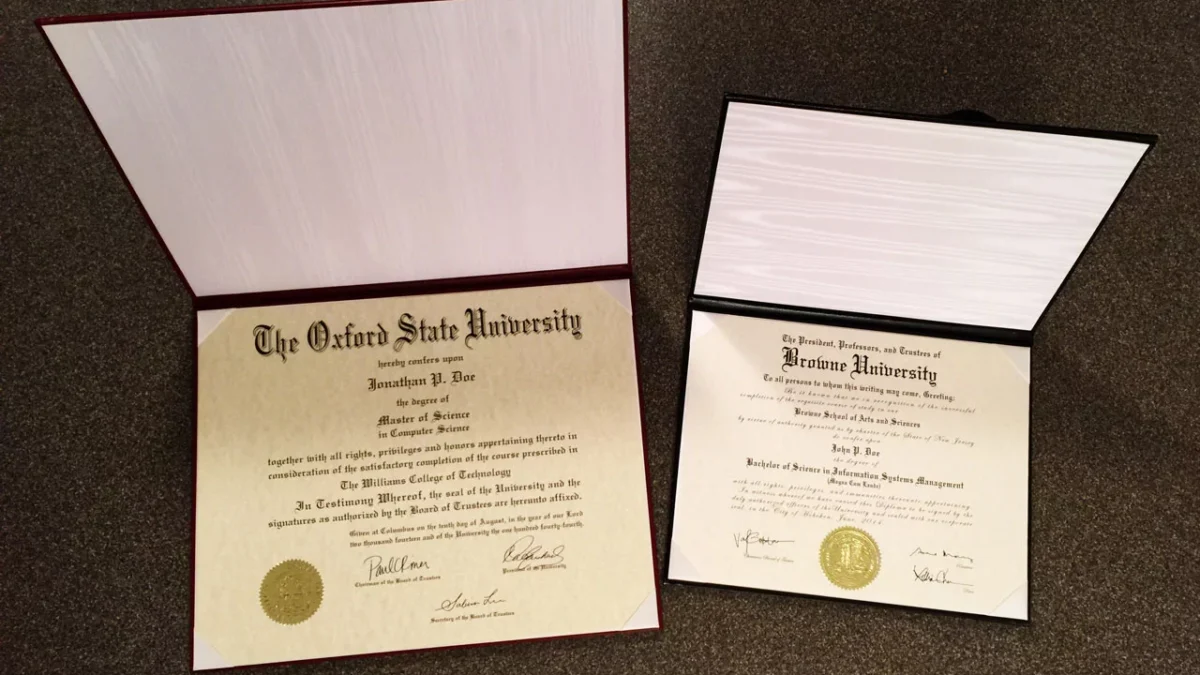
Why Buy a Novelty Diploma? 5 Fun and Legitimate Reasons
April 12, 2025
Most Popular and Growing Degrees and Majors in U.S. Colleges for 2025
April 24, 2025Exploring Diploma Sizes: High Schools and Universities Worldwide
Introduction
Diplomas10.11.4Diplomas mark significant academic achievements, proudly displayed in homes and offices. Beyond their symbolic value, the physical size of diplomas varies widely across high schools and universities globally. From compact certificates to grand parchments, these documents reflect institutional traditions and practical considerations. This article explores the diverse diploma sizes offered by high schools and universities worldwide, highlighting common dimensions, regional differences, and factors influencing their design.
Why Diploma Sizes Matter
Diploma size impacts how these credentials are framed, stored, and displayed. A standard size simplifies framing, while unique dimensions may require custom solutions, adding cost and complexity. Sizes also carry cultural significance—larger diplomas often convey prestige, while smaller ones prioritize practicality. Understanding these variations helps graduates plan for preservation and presentation.
High School Diploma Sizes
High school diplomas vary by country and institution, influenced by educational systems and administrative preferences. Here are common sizes observed globally:
- United States: U.S. high school diplomas typically measure 8.5 x 11 inches, aligning with standard letter paper. This size, used by many public and private schools, is practical for mailing and framing. For example, graduates from institutions like Crimson Global Academy receive diplomas in this format, matching the U.S. standard for ease of recognition.
- United Kingdom: UK qualifications like the General Certificate of Secondary Education (GCSE) or A-Level certificates are often A4-sized (8.27 x 11.69 inches), reflecting the ISO paper standard prevalent in Europe. International Baccalaureate (IB) diplomas, offered globally, also adopt A4 for consistency across countries.
- Canada: Canadian high school diplomas, such as Ontario’s Secondary School Diploma, often follow the U.S. 8.5 x 11-inch standard, though some provinces issue slightly larger certificates (e.g., 9 x 12 inches) for ceremonial impact.
- Australia: Australian high school certificates, like the Higher School Certificate (HSC), are typically A4-sized, mirroring UK standards. Vocational qualifications may use smaller formats, such as 6 x 8 inches, for certificates of completion.
- France: The Baccalauréat diploma is usually A4-sized, consistent with France’s adoption of ISO standards. Smaller certificates for specific streams (e.g., vocational Bac) may measure 5.8 x 8.3 inches (A5).
- India: Indian high school certificates, such as the CBSE Class 12, are often A4-sized, though some state boards issue larger formats (e.g., 10 x 13 inches) to emphasize achievement.
High school diplomas prioritize functionality, with sizes often aligning with regional paper standards to reduce printing and distribution costs.
University Diploma Sizes
University diplomas span a broader range, reflecting academic level, institutional prestige, and cultural norms. Below are typical sizes by degree type and region:
- United States:
- Bachelor’s and Master’s Degrees: Most U.S. universities issue diplomas at 8.5 x 11 inches, the standard letter size. For example, the University of Michigan uses this dimension for most degrees.
- Doctoral Degrees: Larger sizes are common, such as 11 x 14 inches, to signify higher achievement. Michigan’s medical school (MD) diplomas, however, are notably larger at 15.75 x 22 inches, emphasizing their distinct status.
- Certificates and Minors: Smaller credentials, like graduate certificates, may measure 6 x 8 inches, distinguishing them from full degrees.
- United Kingdom:
- Undergraduate and Postgraduate Degrees: UK universities typically use A4 (8.27 x 11.69 inches) for bachelor’s, master’s, and doctoral diplomas. The Open University and others adopt this size for distance learning credentials.
- Higher National Diplomas (HND): These vocational qualifications are often A4 but may be smaller (e.g., 7 x 9 inches) for specific programs.
- Canada:
- College Diplomas: Ontario’s two- and three-year college diplomas (e.g., Ontario College Advanced Diploma) are typically 8.5 x 11 inches, mirroring U.S. standards.
- University Degrees: Canadian universities like those in Ontario issue bachelor’s and master’s diplomas at 8.5 x 11 inches, with doctoral degrees occasionally larger (e.g., 11 x 14 inches) for ceremonial purposes.
- Germany and Central Europe:
- Diplom Degrees: In Germany, Serbia, and Hungary, the traditional Diplom (comparable to a bachelor’s/master’s) is often A4-sized, reflecting the region’s standardized paper use. Doctoral diplomas may be larger, around 9.8 x 13.8 inches, to denote prestige.
- Singapore:
- Japan:
- University Diplomas: Japanese degrees are often A4-sized, aligning with global standards. Certificates of graduation from shorter programs may be smaller, around 6 x 8 inches, for vocational training.
University diploma sizes balance tradition and practicality. Prestigious institutions may opt for larger formats to enhance visual impact, while others standardize to streamline production.
Factors Influencing Diploma Sizes
Several factors shape diploma dimensions:
- Paper Standards: Regions using A4 (Europe, Asia) or letter size (North America) often align diplomas accordingly for cost efficiency.
- Cultural Significance: Larger diplomas symbolize greater achievement in some cultures, particularly for advanced degrees.
- Framing Trends: Common sizes (e.g., 8.5 x 11 inches) match readily available frames, reducing costs for graduates.
- Material and Design: Historically, diplomas used durable sheepskin, influencing size for portability. Modern parchment or paper allows flexibility but retains traditional aesthetics.
- Administrative Needs: Smaller certificates are easier to mail or store, while larger ones suit ceremonial displays.
Regional Variations and Trends
- North America: The 8.5 x 11-inch standard dominates due to widespread use of letter paper. Exceptions, like oversized medical or doctoral diplomas, highlight specialization.
- Europe: A4 is near-universal, driven by ISO standards. Larger sizes are rare, reserved for honorary or artistic credentials.
- Asia: A4 prevails in countries like Japan and Singapore, but traditional calligraphy or ornate borders may lead to unique sizes (e.g., 9 x 12 inches) for cultural emphasis.
- Latin America: Mexican and Brazilian universities often use A4, though vocational certificates may be smaller (5.8 x 8.3 inches) for short courses.
A growing trend is digital diplomas, which eliminate physical size constraints. However, printable versions often default to A4 or letter size for compatibility with home printers.
Challenges of Non-Standard Sizes
Non-standard diploma sizes pose challenges:
- Framing Costs: Unique dimensions (e.g., 15.75 x 22 inches) require custom frames, increasing expenses.
- Storage: Oversized diplomas are harder to file or protect, risking damage.
- International Recognition: Foreign institutions may issue unfamiliar sizes, complicating evaluation for U.S. equivalency. Credential agencies like Josef Silny & Associates note size discrepancies during validation.
Graduates with non-standard diplomas should measure precisely (height and width in inches) to ensure proper framing.
Conclusion
Diploma sizes reflect a blend of practicality, tradition, and regional standards. High schools lean toward functional sizes like 8.5 x 11 inches (U.S.) or A4 (Europe, Asia), while universities diversify, with larger formats (e.g., 11 x 14 inches) for advanced degrees. Graduates should consider framing availability and storage when receiving their credentials. Whether a compact certificate or an imposing parchment, the diploma’s true value lies in the achievement it represents, not its dimensions.





